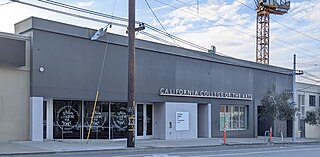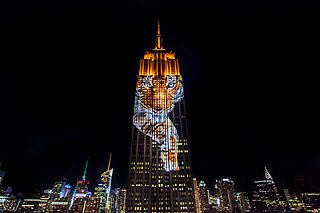
Burning Man is a week-long large-scale desert event focused on "community, art, self-expression, and self-reliance" held annually in the western United States. The event's name comes from its culminating ceremony: the symbolic burning of a large wooden effigy, referred to as the Man, that occurs on the penultimate night, the Saturday evening before Labor Day. Since 1990, the event has been at Black Rock City in northwestern Nevada, a temporary city erected in the Black Rock Desert about 100 miles (160 km) north-northeast of Reno. According to Burning Man co-founder Larry Harvey in 2004, the event is guided by ten stated principles: radical inclusion, gifting, decommodification, radical self-reliance, radical self-expression, communal effort, civic responsibility, leaving no trace, participation, and immediacy.

Joe Mangrum is an installation and multiple-medium artist who is particularly known for his large-scale colored sand paintings. He resides in New York City. Using a wide spectrum of components, his work often includes organic materials, such as flowers, food and sand, in addition to deconstructed computer parts, auto-parts and a multitude of found and collected objects. His installations often include mandala-like forms, pyramids, maps, grids and mushroom clouds and the Ouroboros.
David Best is an internationally renowned American sculptor. He is well known for building immense temples out of recycled wood sheets for the Burning Man festivals, where they are then burnt to the ground in a spectacle of light and heat.
Alice Aycock is an American sculptor and installation artist. She was an early artist in the land art movement in the 1970s, and has created many large-scale metal sculptures around the world. Aycock's drawings and sculptures of architectural and mechanical fantasies combine logic, imagination, magical thinking and science.

Flaming Lotus Girls is a volunteer-based group of artists who make large-scale kinetic fire art. FLG has been described as a "women-focused anarchist art collective." The group began in 2000, in San Francisco, California, as a group of six women and two men who wanted to gain the fabrication and design experience needed to create large sculptural installations. The group includes over a hundred members of all genders, and a majority of the members are women. Many of the sculptures have interactive elements, allowing the audience to control the lighting, flames, sound, or other effects. The collective's work has appeared throughout the United States, as well as in Canada, Australia, and the Netherlands.

Stephanie Syjuco, is a Filipino-born American conceptual artist and educator. She works in photography, sculpture, and installation art. Born in the Philippines, she moved to the San Francisco Bay Area in 1977. She lives in Oakland, California, and teaches art at the University of California, Berkeley.

Christian Ristow is an American robotic artist. He is known for his robotic performance art under the name Robochrist Industries, his animatronics work in film and television, and his large-scale interactive sculptures.

The Chinese Culture Center of San Francisco is a community-based, non-profit organization established in 1965 as the operations center of the Chinese Culture Foundation located in Hilton San Francisco Financial District, at 750 Kearny Street, 3rd Floor, San Francisco, California, United States.

The Wattis Institute for Contemporary Arts is a nonprofit contemporary art center and research institute in San Francisco. It is part of the California College of the Arts. The institute holds exhibitions, lectures, and symposia, releases publications, and runs the Capp Street Project residency program.

Cyclecide is an American bicycle club based in San Francisco, California, composed of clowns, altered bikes, and a traveling show called "The Bike Rodeo", which is a public performance, and not a bicycle rodeo, a children's bicycle safety clinic.

Amar Kanwar is an Indian filmmaker. His work challenges the limits of the medium in order to create complex narratives traversing several terrains such as labour and indigenous rights, gender, religious fundamentalism and ecology.
Mike Ross is an American sculptor known for large scale public art projects.

Obscura Digital is a creative studio located in historic Pier 70 in the Dogpatch District of San Francisco, California.

Pepe Ozan (1939–2013) was an Argentine sculptor, artistic director, and filmmaker. He lived in the San Francisco Bay Area for many years, and is known for his lasting influence at Burning Man, an annual experimental arts festival in Nevada, United States.
Mark Grieve is an American contemporary artist. He practices in a variety of media including found objects and large metal sculpture as well as site-specific installations, performance, and public art.
Jen Lewin is an American interactive artist and engineer. She is based in New York City and specializes in large scale installations in public spaces, usually combining elements such as light, sound and complex engineering. Her interactive light installation The Pool debuted in 2008 and has been exhibited across the globe, in cities such as Singapore, Sydney, Denver, Montréal and Prague, and in events such as South By Southwest and Burning Man.

Marco Cochrane is an American sculptor born in Venice, Italy, best known for his large-scale steel sculptures of nude women.
Ball-Nogues Studio is a design and fabrication practice based in Los Angeles, California, founded by Benjamin Ball and Gaston Nogues, and currently led by Benjamin Ball. The studio's work falls between the categories of art, architecture and industrial design. The practice is known for creating site-specific architectural installations out of unorthodox materials such as stainless steel ball-chain and spheres, paper pulp, garments, and coffee tables. The studio focuses on the process of creation, with an emphasis on the research and exploration of materials and fabrication methods. Much of the studio's work involves expanding the potential of materials and manufacturing techniques.

The Raygun Gothic Rocketship is a retro-futurist art sculpture in the shape of a giant rocketship. It was created by Bay Area artists Nathaniel Taylor, Sean Orlando, and David Shulman.
Ryan C. Doyle is a visual artist known for his large-scale fabricated sculptures, parade floats, art cars, and sculptures, sometimes involving robotics, animatronics, pyrotechnics, and military technologies. He is from the Twin Cities, Minnesota, and resides in Detroit, Michigan, where he has contributed to permanent installations at The Lincoln Street Art Park and Recycle Here! recycling center.














